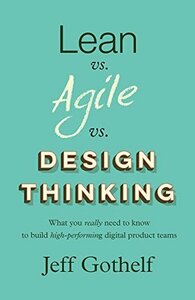Take a photo of a barcode or cover
This book was interesting, it did include some definition of agile that I think are wrong. Making me unsure about the rest of the book. Other things where insightful.
This is a very short, high-level primer on the methodological differences between domains in software product development . It should be considered only as an introduction to other learning, because it won't tell you how to conduct any of these practices. It will, however, point out the common friction points between the PMs, the devs, and the designers.
More of a lecture than a book. Short, but very valuable to me in thinking through how these practices relate to each other.
A summary of a current quandary in the product development and UX worlds. I enjoyed it, but knew it was high level because the audiobook was only 45 minutes and cost $1.95. I listened to it twice to make sure I didn't space out during something important.
Agile: "We value responding to change over following a plan."
"The challenge with Agile is that its authors never addressed how to implement it at scale. The Agile Manifesto speaks to team-level practices. Incorporating continuous feedback at that level is relatively simple.Scale that out to 10, 100, or 500 teams and the potential for organizational chaos grows exponentially. Teams"
"The MVP was designed as a tool of Lean Startup to help teams answer two questions:
1) What's the most important thing we need to learn first on our project?
2) What's the least amount of work we need to do to learn that?
The first question speaks to risks. For the team's current initiative, what's the thing most likely to make it fail? The second questions addresses the real meaning of the MVP, an attempt to do less work before we commit to a full build-out of the feature."
"Agile helps us deliver work in regular cadences. Lean Startup helps us determine what to focus on. How then, do we determine whether we're actually working on something of value? Enter Design Thinking."
"A few core practices serve as effective starting points. I recommend:
1) Work in short cycles
2) Hold regular retrospectives. They are a regular opportunity for the team to consider their current practice, evaluate its efficacy, and determine how to progress.
3) Put the customer at the center of everything. If you're struggling to get alignment as a team, focus on delivering customer value.
Ask on a regular basis: How do we know we're shipping something users care about? How do we find out? How does that affect what we prioritize?
4) Go and see
5) Balance product discovery with delivery work by only testing high-risk hypotheses
6)Do less research more often
7)Work and train as one balanced team
8) Radical transparency
9) Review your incentive structure (and performance management criteria)
10) Make product discovery work a first-class citizen of your backlog "
"At the end of the day, your customers don't care whether you practice agile, lean, or design thinking. They care about great products and services that solve meaningful problems for them in effective ways."
"The challenge with Agile is that its authors never addressed how to implement it at scale. The Agile Manifesto speaks to team-level practices. Incorporating continuous feedback at that level is relatively simple.Scale that out to 10, 100, or 500 teams and the potential for organizational chaos grows exponentially. Teams"
"The MVP was designed as a tool of Lean Startup to help teams answer two questions:
1) What's the most important thing we need to learn first on our project?
2) What's the least amount of work we need to do to learn that?
The first question speaks to risks. For the team's current initiative, what's the thing most likely to make it fail? The second questions addresses the real meaning of the MVP, an attempt to do less work before we commit to a full build-out of the feature."
"Agile helps us deliver work in regular cadences. Lean Startup helps us determine what to focus on. How then, do we determine whether we're actually working on something of value? Enter Design Thinking."
"A few core practices serve as effective starting points. I recommend:
1) Work in short cycles
2) Hold regular retrospectives. They are a regular opportunity for the team to consider their current practice, evaluate its efficacy, and determine how to progress.
3) Put the customer at the center of everything. If you're struggling to get alignment as a team, focus on delivering customer value.
Ask on a regular basis: How do we know we're shipping something users care about? How do we find out? How does that affect what we prioritize?
4) Go and see
5) Balance product discovery with delivery work by only testing high-risk hypotheses
6)Do less research more often
7)Work and train as one balanced team
8) Radical transparency
9) Review your incentive structure (and performance management criteria)
10) Make product discovery work a first-class citizen of your backlog "
"At the end of the day, your customers don't care whether you practice agile, lean, or design thinking. They care about great products and services that solve meaningful problems for them in effective ways."
informative
inspiring
Short, practical and a good starting point for thinking about product organizations and process.
While I didn't learn anything new, being familiar with all of these frameworks and their applications, I still found the succinct way they are summarized here very useful, and the perspective from which they are evaluated - very helpful.
While I didn't learn anything new, being familiar with all of these frameworks and their applications, I still found the succinct way they are summarized here very useful, and the perspective from which they are evaluated - very helpful.
Da buenos consejos para integrar las tres metodologías o filosofías con una conclusión clara: céntrate en el usuario y toma lo que puedas de cada una.


